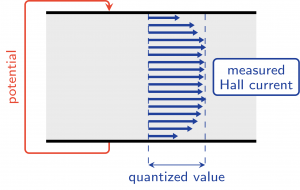Probing chiral edge dynamics and bulk topology of a synthetic Hall system
The Bose-Einstein condensate team has studied the dynamics of dysprosium atoms manipulated by lasers, aiming to simulate the behavior of electrons in a magnetic field, which feature a quantum Hall effect. We used two-photon transitions to couple the atomic motion and the internal spin state, which plays the role of a `synthetic’ dimension. As expected in Hall systems, we found a freezing of motion in the system bulk, and a chiral motion on the edges. We also measured the response of the atoms to a force, observing a quantized motion along the direction perpendicular to the force. The robustness of this behavior illustrates a property of non-trivial topology of the quantum states. This setting will be the frame for future studies of topological phases in interacting atomic systems.
Link to the complete article : https://www.nature.com/articles/s41567-020-0942-5
Scheme of the Hall response measurement. We measured the atom velocity induced by a transverse potential. In the bulk of the system, the Hall currents are consistent with a quantized hall response.

Scheme of the Hall response measurement. We measured the atom velocity induced by a transverse potential. In the bulk of the system, the Hall currents are consistent with a quantized hall response.
